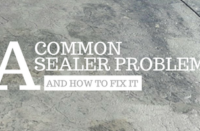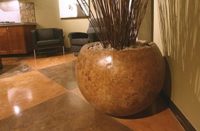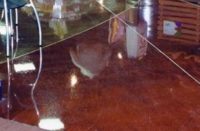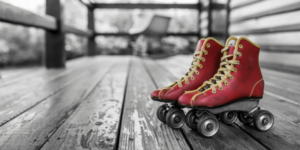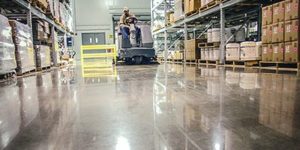In the 30-odd years I’ve been in the concrete industry, first as a contractor and now as a retailer, I’ve heard time and again that water-based acrylic sealers can’t compare to solvent-based acrylics. I don’t know who came up with this idea or how it became so universally accepted. Maybe it was true “back in the day,” however, based upon my own observations and experimentation, I no longer subscribe to that train of thought. In fact, I believe using water-based acrylics can be beneficial in many cases.
The turning point
My pessimistic attitude toward water-based sealers began to change about five years ago. I had recently quit contracting and had taken a new job selling decorative concrete supplies. While sampling sealers from a number of manufacturers, I tested both solvent-based acrylics and water-based acrylics on stamped and colored concrete.
One day I stripped the sealer off a very small 1-by-1-foot section so I could test some acid stain. In the past, if I needed to strip a small bit of acrylic sealer, I simply used xylol and a rag. That was my plan this time, too.
I applied the xylol to some water-based acrylic sealer and, to my surprise, nothing happened. I applied more, and really let it puddle and sit for a while. After wiping off the still-wet xylol with a rag and the sealer, the area remained unaffected. I applied more xylol and vigorously scrubbed the area with a stiff brush and a terry cloth. After about 10 to 15 minutes of constant work, I had only stripped an area about the size of a quarter dollar. I quickly concluded that if water-based sealer was tough enough to withstand that kind of abuse, it would do equally well in normal weather.

New regulations, new carriers
Not long after this experience, I got word that Indiana was adopting new regulations regarding solvent-based sealers. Due to changes in VOC laws, xylol would no longer be a component. Instead, acetone and its derivatives would be the new carriers. Unlike xylol, these solvents are notorious for drying extremely quickly. Many dry much too quickly to be used effectively. With that in mind, I knew my customers would have to learn a whole new way of doing things. I began to experiment with VOC-compliant sealers to see what was in store for my contractors.
I found rolling these fast-drying sealers was problematic, especially in hot weather. Often, the sealer would dry so quickly that it would begin to “cobweb” from the roller. Fine strands of sealer would float around in the air like wisps of cotton candy.
Even when the application appeared to go well, there were often well-defined roller marks after the sealer dried. These were apparently caused by a double coat of sealer between roller passes. The solvent would flash off so quickly that the sealer could not melt into itself as it was being rolled. Streaking was even more prevalent when using brown-tinted concrete sealer on exposed aggregate surfaces.
In addition to the streaking issue, bubbles would often times form in the sealer. These could either be large bubbles, about an inch in diameter, or thousands of tiny closely spaced bubbles which gave the impression that the sealer had blushed (whitened). There were also times when tiny bubbles were invisible, but became very noticeable when they crackled loudly underfoot. Sometimes, there appeared to be no problems at all, but three weeks later bubbles would form! Clearly, there had to be a solution.
A side-by-side test
About that time, I asked a sealer manufacturer to formulate a dark brown-tinted concrete water-based sealer for me to test. I poured a small sample of exposed pea gravel concrete. On one half of the sample, I applied brown-tinted concrete solvent-based acrylic sealer. On the other half, I applied the brown-tinted concrete water-based acrylic sealer. Initially, both sides looked good. They were both nice and shiny, but the preference was the darker pigment that had been added to the special water-based sealer.
I set this sample outside my store, directly under a downspout. Each time it rains, water beats down upon it. In the past four years, the solvent-based sealer has completely weathered away. On the other hand, the water-based sealer still appears nearly the same as it did when applied. It has lost a bit of gloss, but the rich color and slight sheen are still intact.
Pros and cons
Based on my observations, I have begun advocating the use of water-based acrylic sealers over solvent-based ones for all types of concrete. Benefits of water-based sealers include:
- Don’t release harmful vapors into the atmosphere.
- Are far safer for the worker to apply, especially indoors.
- Are easier and cheaper to apply because they can be sprayed on with a cheap plastic garden sprayer and don’t flash dry during warm weather.
- Eliminate or reduce most sealer problems including bubbling and roller marks.
- They are often more durable.
- Are available in high-gloss or matte finishes.
- Don’t darken the surface nearly as much as solvent-based sealers, so the surface looks much more natural. To some, that’s an advantage when installing decorative concrete.
- Water-based acrylic cure-and-seals work just as well as solvent-based ones for curing plain concrete — again without darkening the surface.
In fairness, water-based sealers do have some drawbacks. They include:
- Water-based sealers are very difficult to remove if a problem should occur.
- They don’t work well when applied at temperatures below 50 degrees Fahrenheit.
- Water-based sealers will freeze and become unusable much more easily than solvent-based acrylics.
- They do not provide the darkening effect that some customers prefer, especially on decorative concrete.
- When exposed to long periods of wet weather, they may re-wet and appear milky. Typically, though, when the surface dries, the sealer once again becomes clear.
Taking all things into consideration, it may make your life easier if you try water-based sealer on your next project. Your employees, as well as the rest of the planet, will benefit as well.
Questions from Readers
Question
Can you use a water-based sealer on top of an old water-based sealer like you can with a solvent-based sealer?
Answer from Concrete Decor
You can use the same type of sealer over top an existing sealer but first thoroughly clean your surface. Also, start by applying your new sealer in a small test area and let it sit for a day or two if you have the time. Making sure you have a good bond with the new sealer is critical. Some sealers have trouble bonding because of new VOC laws. It’s always good to test first.
Also, when applying, do it in the cool of the day and with a couple of thin coats. Never apply one heavy coat.
Question
What water-based acrylic sealer for driveway pavers do you recommend? It was a recommendation to me to use a product called Ultra Wet Look by Wet Look Paver Sealers but it is very expensive ($200/5 gallon). I need to cover about 1,100 sq. ft. I found Eagle Natural Seal at Home Depot for $90/5 gallon, but it doesn’t specify for driveway pavers. Thanks for your article. It was very helpful.
Answer from Concrete Decor
There is also a water-based penetrating sealer that will do the same job but it’s not as effective at bringing out the color in your pavers. Either of these should be spray applied with a pump-type sprayer and back-rolled with a 1/2-inch roller on an extension pole. Remember, a few light coats are better than one heavy coat. It dries fast so you should be able to get the job done in a morning when the sun isn’t beating down on your surfaces.
Question
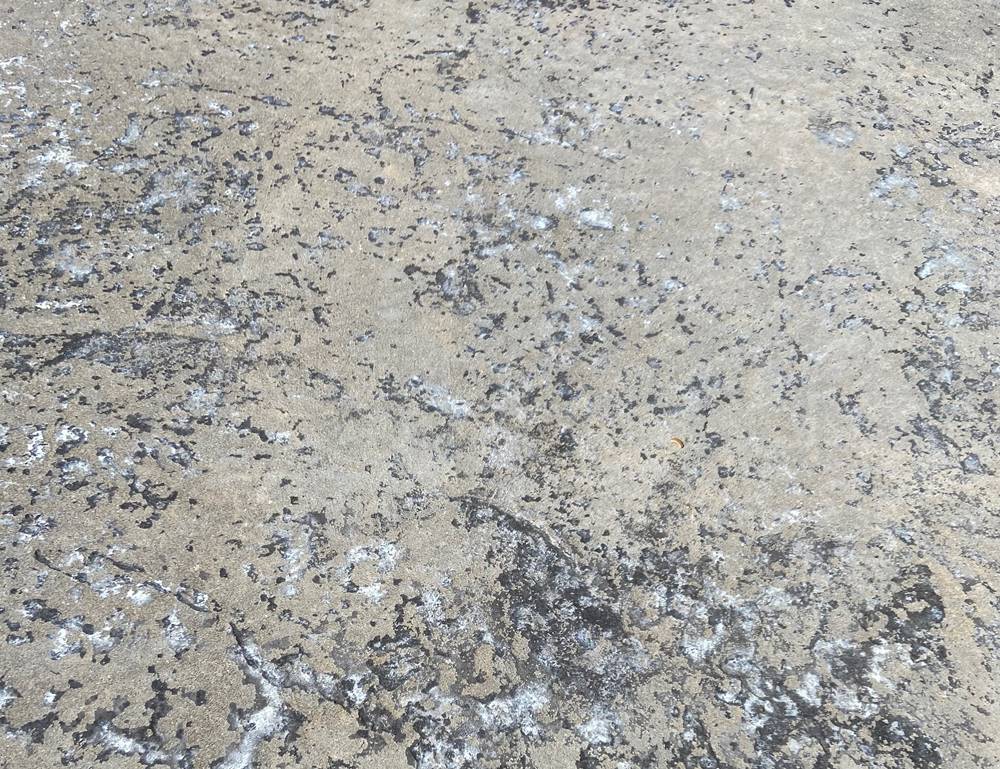 About 3 years ago I installed a water-based acrylic sealer to my patio. As you can see in the picture, a lot of the sealer has flaked off and/or is delaminated. Some sealer is still well bonded. I’ve tried cold-water pressure washing the remaining sealer off, without success. Any chemical suggestions to remove the remaining sealer without damaging adjacent landscaping?
About 3 years ago I installed a water-based acrylic sealer to my patio. As you can see in the picture, a lot of the sealer has flaked off and/or is delaminated. Some sealer is still well bonded. I’ve tried cold-water pressure washing the remaining sealer off, without success. Any chemical suggestions to remove the remaining sealer without damaging adjacent landscaping?
Answer from Concrete Decor
If, in fact, the sealer is an acrylic the Deco-Peel stripper is a good choice. Each kit covers a 400-sqare-foot area. Lay the fabric down, thoroughly wet it and allow it to do its work. When the fabric is fully dry, peel it up and it will take all the sealer with it.
I recommend a penetrating sealer. Solvent-based sealers darken the concrete color. Water-based sealers do not change the concrete color. These solvent- and water-based penetrating sealers are not film forming and reduce the risk of slip/fall hazards.
